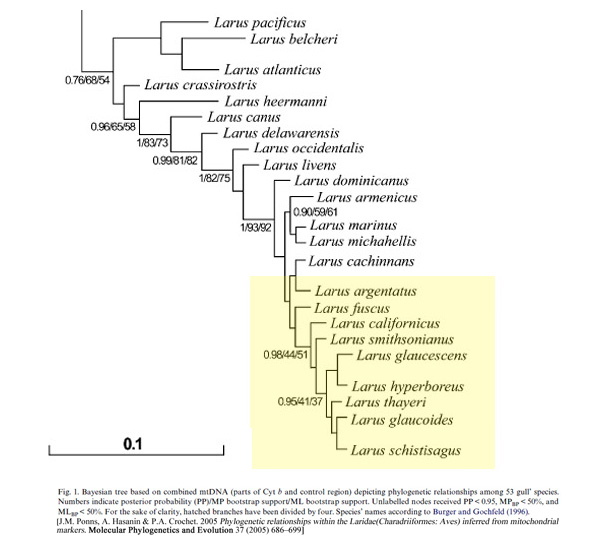Thayer’s ain’t so, Joe
BREAKING NEWS [03/29/2017]: The new list of NACC proposals is out and proposal 7 (page 29) is to lump Thayer's Gull...
http://checklist.aou.org/assets/proposals/PDF/2017-C.pdf
One cannot spend time sorting through gulls without, at some point, falling into the black hole that is the Iceland/Kumlien’s/Thayer’s puzzle. A few years back I suggested (to nobody’s amusement, but my own) that the complex be renamed Schrödinger’s Gull. On purely technical grounds, the issue is more about observational relativism than it is quantum uncertainty, but Schrödinger’s has a nicer ring to it and gets to the random heart of the problem in a way that Einstein’s Gull does not. But I digress…
If one sees a member of this complex in Europe, things are pretty straightforward. It’s an Iceland Gull. Here in North America things get more complicated. East Coast birds are (most of them anyway) considered to be the Kumlien’s form of Iceland Gull which has (on average) grayer primary tips than European forms. To the West, there is the much darker Thayer’s Gull which has a more complicated taxonomic history and requires a bit of backstory.
For those of you old enough to remember, Thayer’s Gull used to be considered a subspecies of Herring Gull. Two studies led to the split that gave Thayer’s Gull its independence. The first was by A.H. Macpherson [1961. Observations on Canadian Arctic Larus gulls, and on the taxonomy of L. thayeri Brooks. Arctic Institute of North America Technical Paper 7:1-40] which demonstrated that there was positive assortment to species in areas of sympatry between Herring and Thayer’s Gulls. The second was a more controversial (to be polite) study done by N.G. Smith which was eventually featured in Scientific American [1967. Visual isolation in gulls. Scientific American 217(4): 94-102]. Smith’s work showing assortment has never been replicated and other studies would seem to contradict many of his conclusions. Some within the ornithological community have even suggested that he faked his data. Having read through Smith’s original publications and subsequent critiques and rebuttals, I have reached the personal conclusion that the study has flaws, but the primary problems were observer bias (especially among his locally sourced assistants) and inadequate sample size, not fraud. Much like the current problem with sorting Thayer’s from Kumlien’s in the field, Smith saw what he (and probably his major professors) expected to see and there were no independent controls to rein in the biases.
But that was 50 years ago. What about now? Surely modern cladistics and the genetics revolution can get us to the truth. Not so fast. There are several competing hypotheses for the taxonomic state of things beginning with the current American Ornithologist’s Union (AOU) model which holds Thayer’s as a separate species and Kumlien’s as a subspecies of Iceland. Most of these hypotheses can find at least one champion among the cladists. So, hypothetically, we could say one of the following:
- Thayer’s is a separate species and Kumlien’s is a recognizable subspecies of Iceland.
- Thayer’s, Kumlien’s and Iceland are three species with fuzzy distributional edges.
- Thayer’s and Iceland are separate species and Kumlien’s is a hybrid (the fuzzy middle) between the two.
- Thayer’s is a subspecies of Iceland and the differences represent a cline of variation from east to west.
There are additional sub-hypotheses regarding the taxonomic value of sorting populations into subspecies and/or clinal subpopulations without usefully discrete phenotypical or ecological boundaries.
No one goes for hypothesis #2 much these days. The clinality (if that’s a word) of characters between Kumlien’s and Iceland have been well established in multiple studies. The clinal relationships between Thayer’s and Iceland forms are less clear-cut and are best described as blotchy. Intermediate gulls are debated ad nauseum and there is a decided east coast vs west coast bias among identifiers regarding what constitutes dark enough to be Thayer’s or light enough to be Kumlien’s. Blotchy is the best way to describe their genetic relationships as well.
In general, most Northern White-head Gulls show confusing genetic relationships [J.-M. Pons, A. Hassanin, P.-A. Crochet, 2005, Phylogenetic relationships within the Laridae (Charadriiformes: Aves) inferred from mitochondrial markers. Molecular Phylogenetics and Evolution 37 (2005) 686–699], so making taxonomic claims based on genetics is problematic, especially among the very closely related members of the Iceland Gull Complex. It has even been suggested that there may not be enough consistent genetic variation in the entire Large White-headed Gull clad to justify any of them being separated into species.

Lumping all larids is probably not going to happen anytime soon, but the tide of scientific opinion is running against Thayer’s Gull as a discrete biological unit. Most European ornithological groups have already lumped Thayer’s into the Iceland complex. The AOU is the last big holdout. I see a time in the not too distant future when we will see this complex lumped into a single, highly variable species and arguments about Thayer’s vs Iceland will become a thing of the past (for non-academic folks, anyway).





Comments
Speciation in progress...Please Wait...
Add a Comment